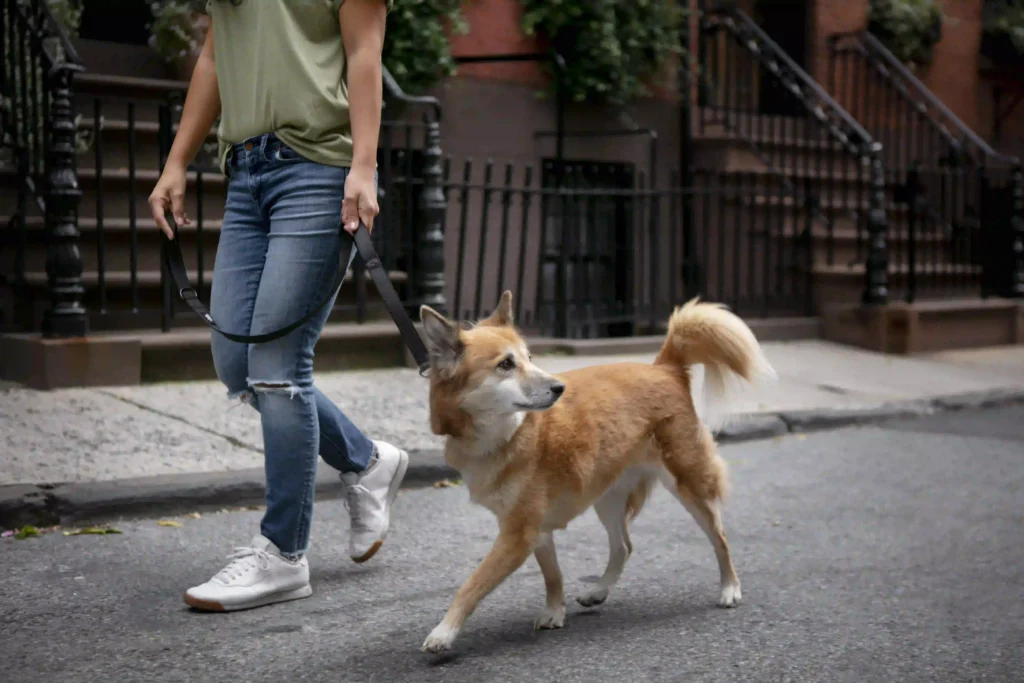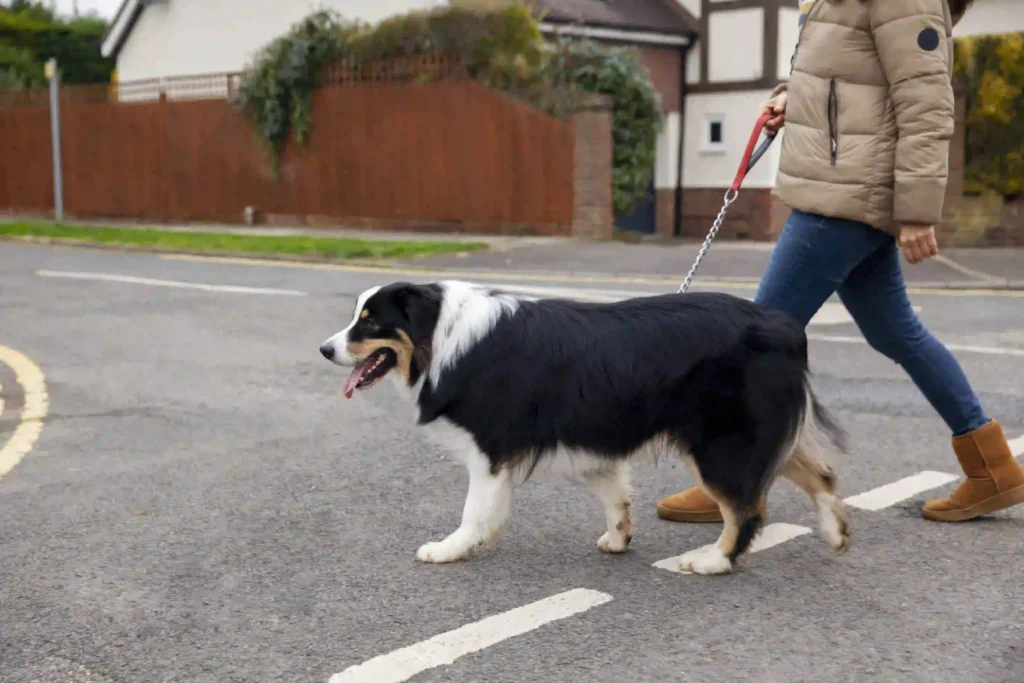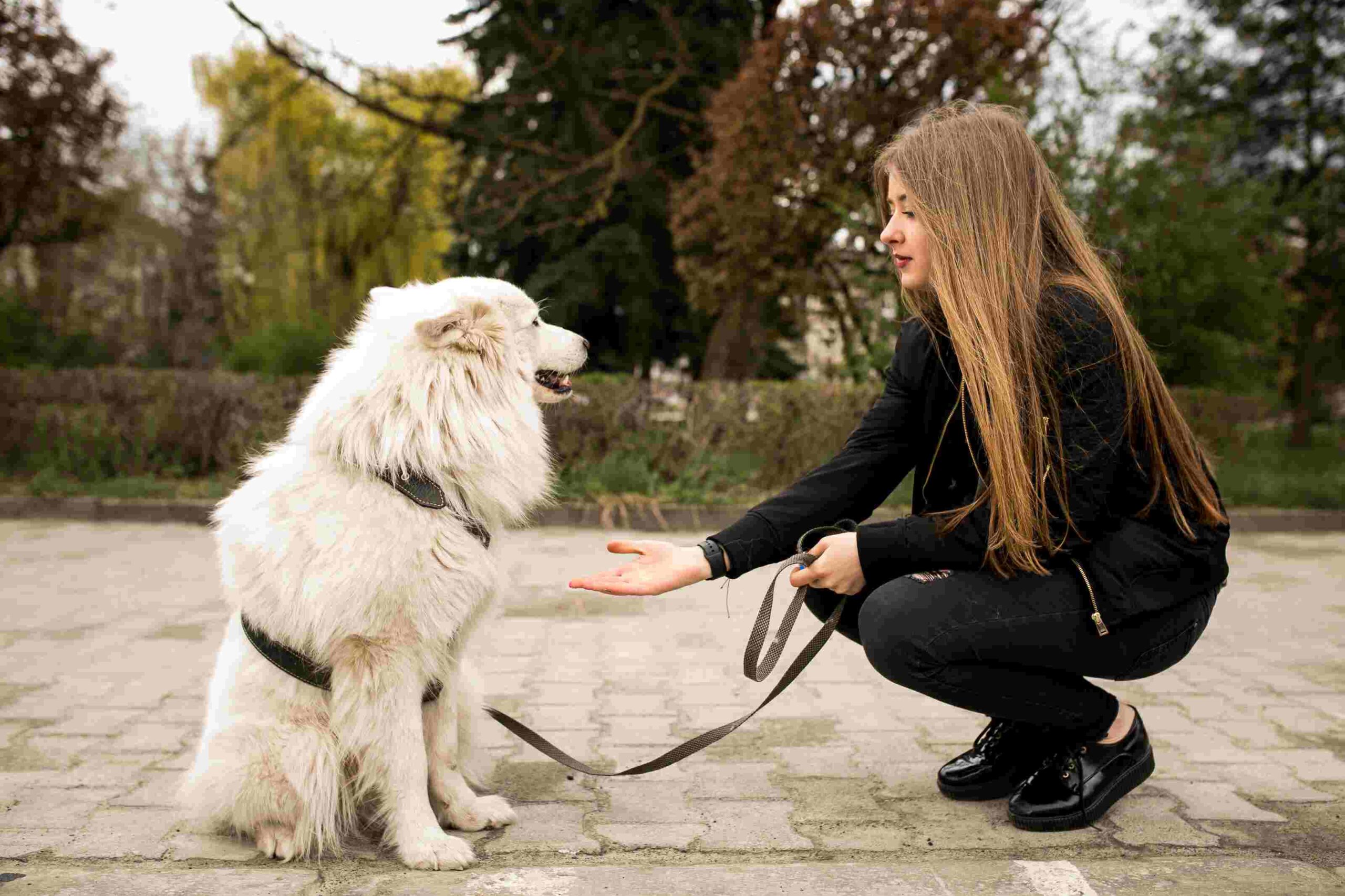Written by Deborah Foster, Certified Dog Trainer & Canine Behavior Specialist with 10+ years of experience in leash training, obedience, and behavior improvement. Reviewed by Erik Prins, ADAB, CCAB.
Leash training is a crucial skill that ensures your dog’s safety, enhances your bond, and makes daily walks enjoyable.
However, many pet owners struggle with leash pulling, reactivity, and distractions.
This comprehensive guide, backed by expert insights, scientific principles, and real-life owner experiences, will walk you through every step of leash training—from introducing the leash to mastering loose-leash walking.
Wondering what leash training can do for you? Here are the benefits that make it worth your time.
The Benefits of Leash Training
Here’s why investing time in this skill pays off for you and your furry friend:
- Stress-Free Walks for You: Imagine strolling through your neighborhood without being yanked or tangled up. A leash-trained dog walks calmly by your side, turning a chaotic tug-of-war into a relaxing outing you’ll both look forward to.
- A Happier, Calmer Dog: Dogs thrive on structure. Learning to walk on a leash reduces their anxiety by giving them clear expectations, helping them feel secure and focused instead of overwhelmed by distractions.
- Stronger Bond: Every step you take together builds trust. As you guide your dog with patience and rewards, they see you as a dependable leader, strengthening your relationship in a way that lasts beyond the walk.
- Safer Adventures: A dog that stays close and responds to you is less likely to dart into traffic, pick fights with other pets, or snatch something harmful off the ground. Leash training keeps them out of trouble—and keeps your heart rate down.
- More Freedom to Explore: With good leash manners, you can confidently take your dog to parks, pet-friendly cafes, or busy streets. It opens up a world of shared experiences that untrained dogs might miss out on.
Why Leash Training is Essential for Your Dog’s Safety and Behavior
Walking your dog is not just about exercise—it’s about teaching them discipline, control, and confidence.
Dogs that are well-leash trained experience fewer behavioral issues, reduced anxiety, and safer interactions with people and other animals.
Expert Insight: “Leash training builds trust and establishes you as a leader. A well-trained dog is less likely to develop leash-related aggression or fear-based behaviors,” says Michael Baugh, Puppy Training Expert at Pet Tame.
Additionally, many cities have strict leash laws.
A trained dog will ensure compliance with these regulations while enjoying a safe and fun walking experience.
When to Start Leash Training Your Dog
The best time to start leash training is as early as 8 weeks old.
However, adult dogs and rescues can still learn proper leash manners with patience and consistency.
Training at any stage involves positive reinforcement, structured practice, and gradual exposure to different environments.
Choosing the Right Leash and Collar for Effective Training
Using the right equipment can make or break your training experience. Consider these options:
-
- Flat Collars: Ideal for dogs who don’t pull.
- Martingale Collars: Great for dogs prone to slipping out.
- Harnesses: Reduces strain on the neck; ideal for dogs that pull.
- Retractable Leashes: Not recommended for training as they encourage pulling.
Pro Tip: A 4-6 foot standard leash works best for training, providing enough control without restricting natural movement.
How to Train Your Dog to Walk on a Leash
Leash training is about more than just stopping pulling—it’s about teaching your dog to walk calmly by your side, building trust, and ensuring safety.
This process combines preparation, patience, and positive reinforcement to create a stress-free walking experience.
Here’s how to approach it effectively:
- Set a Positive Foundation: Start by associating the leash with rewards like treats or praise. This builds enthusiasm rather than resistance, especially for puppies or rescues new to leashes.
- Establish Leadership: Use consistent cues (e.g., “Let’s go!”) and gentle guidance to show your dog you’re in control, fostering confidence and focus.
- Adapt to Your Dog’s Needs: Tailor your approach—high-energy dogs may need more exercise first, while anxious dogs benefit from slower exposure to triggers.
- Progress Gradually: Begin in familiar, quiet spaces and slowly introduce busier environments as your dog gains skills, avoiding overwhelm.
This approach lays the groundwork for success, preparing you and your dog for the detailed training steps ahead.
Step-by-Step Guide to Leash Training a Dog
Step 1: Get Your Dog Comfortable with Wearing a Leash
Start indoors where distractions are minimal.
Let your dog wear the leash for short periods during meal times or playtime to create a positive association.
Real Owner Review: “At first, my rescue dog hated the leash. But after letting her wear it around the house with treats, she started associating it with good things!” — Amanda R., Dog Owner

Step 2: Teach Your Dog to Follow You Indoors
Before heading outside, practice walking with your dog in a hallway or backyard.
Hold a treat near your side and reward them for walking next to you.
Use a cue like “Let’s go!” to signal movement.
Step 3: Take Training Outdoors in a Low-Distraction Area
Once your dog is comfortable, move to a quiet outdoor space.
Keep sessions short (5-10 minutes) and reward your dog for maintaining focus.
Pro Tip: Always train before meals when your dog is more motivated by treats.
How to Handle Leash Pulling and Reactivity
What to Do If Your Dog Pulls on the Leash
-
- Stop immediately when your dog pulls. Wait until they come back to you before resuming the walk.
- Use the “turnaround method”: When they pull, change direction to encourage focus.
- Reward loose-leash walking with praise and treats.
From Fear to Freedom: A Comprehensive Guide to Off-Leash Dog Training
Managing Leash Reactivity (Barking, Lunging at Other Dogs/People)
-
- Desensitization: Gradually expose your dog to triggers at a distance while rewarding calm behavior.
- Counterconditioning: Associate scary things (other dogs, bikes) with positive reinforcement.
- Use the “Watch Me” cue: Teach your dog to look at you when distractions appear.
Expert Insight: “Reactivity often stems from fear or frustration. By reinforcing calm behavior, you can reshape your dog’s emotional response to triggers,” explains Kimberly Artley, Training Assistant & Support Coordinator at Pet Tame.
Common Mistakes to Avoid During Leash Training
- Yanking the leash – Can cause fear and injury.
- Using retractable leashes – Encourages pulling and reduces control.
- Skipping warm-up training – Always start in low-distraction environments.
- Lack of consistency – Stick to the same commands and techniques.
Advanced Leash Training: Walking in Crowded Areas
If your goal is to walk your dog in busy streets or parks, practice these techniques:
-
- Keep treats handy to redirect attention.
- Teach a “heel” command for controlled walking.
- Use body blocking (stepping in front) to prevent lunging at people or animals.
Real Owner Review: “Loose-Leash Walking Transformed My Dog’s Behavior”
“My Labrador used to drag me on every walk. With structured training and patience, she now walks beside me, even in crowded areas! I never thought leash training could be this life-changing.” — David M., Dog Owner

Final Tips for Leash Training Success
- Stay Positive: Avoid punishment—dogs respond best to rewards and encouragement.
- Be Patient: Every dog learns at their own pace.
- Use High-Value Treats: Cheese, chicken, or liver treats work wonders.
Conclusion: Take the First Step Toward Stress-Free Walks
Leash training is a journey that requires consistency, patience, and the right techniques.
With expert-backed strategies, real owner experiences, and scientifically proven methods, you’ll set your dog up for success.
FAQs About Leash Training
How long does it take to leash train a dog?
Most dogs take 2–6 weeks to master basic leash manners, but this varies based on age, temperament, and training consistency.
Can you leash train an older dog?
Yes! Adult and rescue dogs can learn leash walking using positive reinforcement and patience.
What if my dog refuses to walk on a leash?
Encourage movement using high-value treats, and practice in a familiar, low-distraction area.
